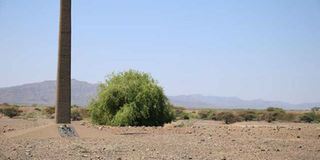Turkana: A paradise for fossil excavators

The site where the fossil of Turkana Boy was discovered at Nariokotome approximately 200km North of Lodwar town, Turkana County. PHOTO | COURTESY
What you need to know:
When archaeologists and paleontologists descend on Lake Turkana basin, they are usually an excited lot as they may stumble on an item, tool or skeleton that could help them find the missing link in the story of the evolution of man and other species.
The basin is rich in fossils and scientists regard it as a reservoir of vital information that can make the world understand its past.
The basin, which includes the world’s largest desert lake and parts of the Omo Delta in southern Ethiopia, has provided evidence of evolution, the advance of technology from stone tools to the Iron Age and the domestication of animals.
Fossil KNM-WT 15000 is famous the world over.
It is kept under lock and key at the national museum since it is the most complete skeleton of a walking early man — dating between 1.5 million and 1.6 million years.
KNM-WT stands for Kenya National Museum, West Turkana.
At the location it was found in Nariokotome, a stone pillar was erected a few years ago.
KNM-WT 15000 is a significant find that helped the world understand the evolution of human beings.
Also known as the Turkana Boy, the skeleton was found in 1984 by Kamoya Kimeu, a celebrated fossil hunter.
TURKANA BOY
“Turkana Boy was Homo erectus — the species that was the first human ancestor and a top predator. He was able to compete with the big cats for meat,” Prof Isaiah Nengo, the director, Research and Science at the Turkana Basin Institute (TBI), said.
“They invented and used sophisticated tools like the hand axe and we strongly believe they were the first human species to use fire.”
Being a hunter, Homo erectus was bigger than his predecessors whose diet was mainly vegetables and whose maximum height was below 4.5ft.
Scientists say Turkana Boy died aged 12 when he was 5.5ft tall.
Had he lived to adulthood, Turkana Boy might have grown to 6ft or more.
According to the fossil evidence, Homo erectus was the first “human” to migrate from Africa to Asia and Europe more than a million years ago.
To celebrate this remarkable find, a monument with a replica of the skeleton was erected close to the excavation site in Turkana North Sub-County, approximately 200 kilometres north of Lodwar, the county headquarters.
EVOLUTION STORY
This was done by the Turkana devolved government, the TBI and the National Museums of Kenya in 2015.
A year before that, another exciting find was unearthed in Napudet, about 20 kilometres east of Lodwar.
It provides evidence of humans and apes originating from Africa.
Before that, it had long been argued by many in the scientific community that the origin of the ape family was Eurasia.
Appropriately named Alesi — which comes from the Turkana word for ancestor “ales”, the 13 million-year-old discovery is the world’s most complete skull.
It was found by Mr John Ekusi during an expedition led by Prof Nengo. Thus, on two separate occasions, Turkana has contributed significantly to the study of palaeoanthropology.
When archaeologists and paleontologists descend on Lake Turkana basin, they are usually an excited lot as they may stumble on an item, tool or skeleton that could help them find the missing link in the story of the evolution of man and other species.
DESERT LAKE
The basin is rich in fossils and scientists regard it as a reservoir of vital information that can make the world understand its past.
The basin, which includes the world’s largest desert lake and parts of the Omo Delta in southern Ethiopia, has provided evidence of evolution, the advance of technology from stone tools to the Iron Age and the domestication of animals.
“In the search for human evolution evidence, Tanzania, Ethiopia, South Africa and Kenya lead. However, Kenya is unique as it provides the proof of Africa being the origin of human beings and apes,” Prof Nengo said.
TBI, founded in 2007 by renowned Kenyan palaeoanthropologist Richard Leakey, has two centres: Turkwel in Turkana County and Ileret in Marsabit.
At any given time, paleontologists teams can be found at excavation sites in Turkana County.
Apart from human evolution, they also want to understand the environment of the early man by studying plant and animal remains.




